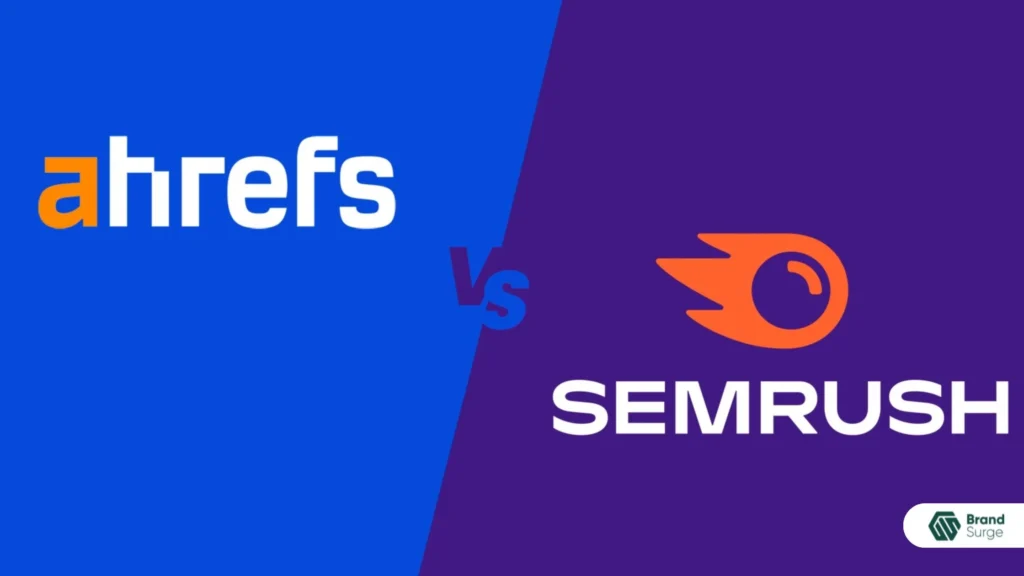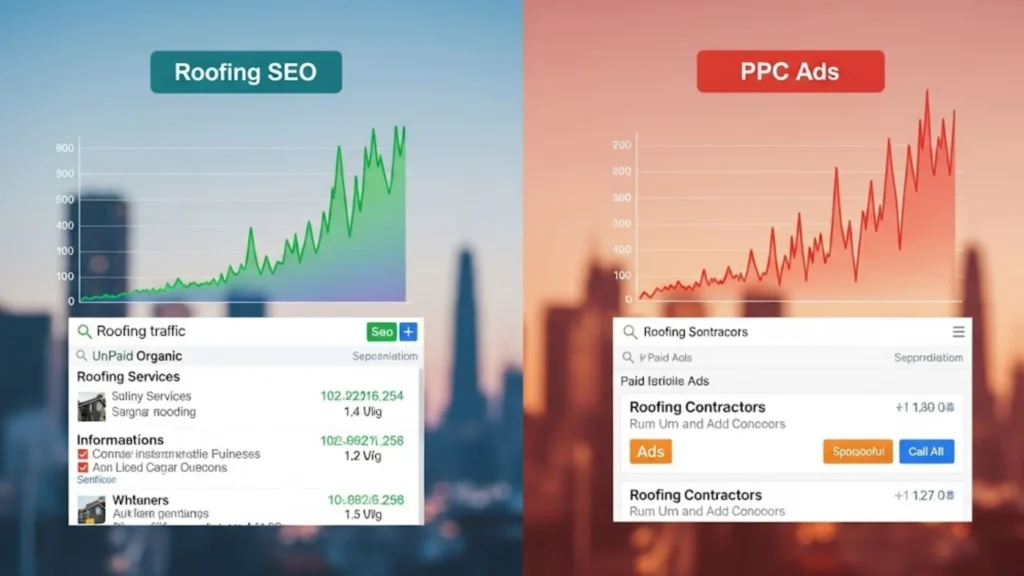When digital marketers weigh the strengths and weaknesses of leading platforms, the discussion around Semrush vs Moz becomes central to selecting the right all-in-one SEO tools. Professionals rely on comprehensive SEO software to drive keyword research, backlink analysis, and site audit insights that translate into measurable growth. Both Semrush and Moz Pro boast robust feature sets that extend beyond basic rank tracking to include in-depth competitor analysis, advanced reporting, and technical optimizations. Evaluating their unique capabilities can clarify which platform aligns best with your team’s objectives and budget. This guide dives into every critical aspect of the Semrush vs Moz debate, helping you make an informed choice.
What are the key differences between Semrush vs Moz?
Semrush and Moz Pro share the same mission: to empower businesses with actionable SEO audit data and performance benchmarks. However, Semrush often leads with a broader suite of digital marketing modules that go beyond pure SEO, including social media management and PPC research. Moz Pro, rooted in a strong community-driven approach, focuses on core SEO functions with metrics like Domain Authority and Page Authority that remain industry benchmarks. Pricing tiers also vary significantly, with Semrush Pro starting higher but offering a wider range of tools, while Moz Pro’s entry point appeals to smaller teams seeking focused SEO reporting.
The architecture behind each platform dictates its core strengths. Semrush taps into a massive database of over 25 billion keywords and 43 trillion backlinks, continuously updated to reflect the latest market shifts. Moz Pro, meanwhile, prides itself on a refined spam score algorithm and a growing backlink index of more than 40 trillion links, combined with straightforward dashboard workflows. These structural choices influence how quickly and accurately each platform surfaces critical insights, from on-page optimizations to off-site link acquisition strategies.
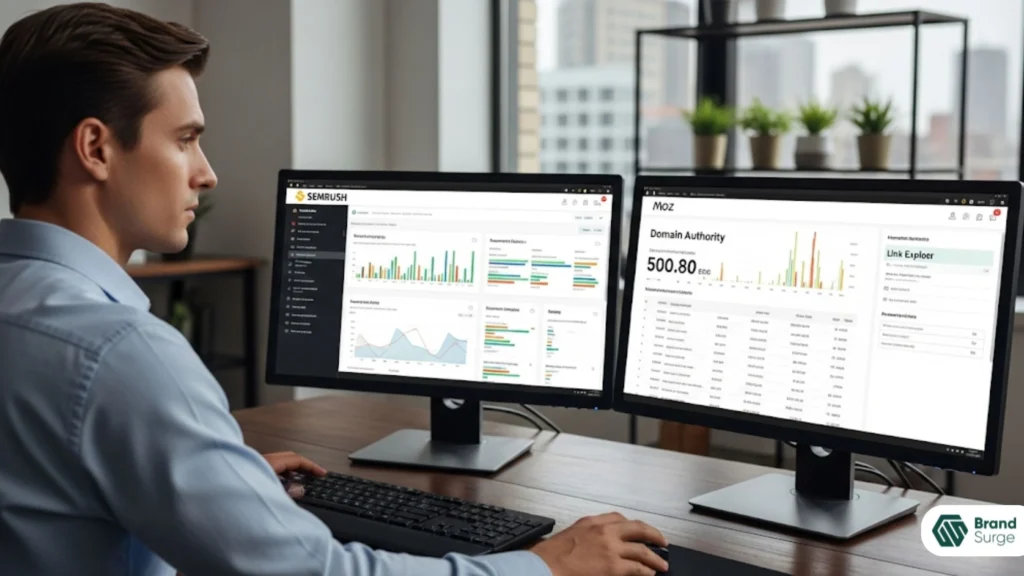
Integration capabilities highlight another point of divergence. Semrush provides native integrations with Google Analytics, Google Search Console, and dozens of third-party tools for seamless data layering. Moz Pro delivers API access for custom reporting but leans on community plugins like MozCast or open-source extensions for extended functionality. For teams prioritizing unified data pipelines, Semrush may present fewer barriers to centralized reporting, while Moz’s API-first approach gives developers flexibility to tailor solutions.
Support models further differentiate the user experience. Semrush offers 24/7 chat support, extensive video tutorials, and dedicated account managers at higher tiers. Moz Pro provides robust documentation, a vibrant Q&A forum, and periodic webinars led by industry experts. Organizations that require real-time troubleshooting and proactive guidance may gravitate toward Semrush, while those comfortable leveraging community insights could find Moz Pro’s peer-driven ecosystem sufficient.
| Feature | Semrush | Moz Pro |
| Keyword Database | 25+ billion keywords | 1.5+ billion keywords |
| Backlink Index | 43+ trillion backlinks | 40+ trillion backlinks |
| Site Audit | 140+ checks | 100+ checks |
| Rank Tracking | Daily updates, 500 keywords | Weekly updates, 300 keywords |
| Competitor Analysis | Advanced insights | Standard overview |
| Starting Price | $129.95/mo (Pro) | $99/mo (Standard) |
How do Semrush and Moz compare in keyword research?
Effective keyword research underpins any successful SEO campaign, and both platforms excel in distinct ways. Semrush delivers granular keyword suggestions drawn from an extensive global database, complete with search volume trends, difficulty scores, and CPC metrics. Moz Pro’s Keyword Explorer emphasizes a streamlined interface, offering click-through rate estimations and prioritization matrices to help users focus on terms with the greatest ROI potential. Marketers must assess whether breadth (Semrush) or curated depth (Moz Pro) aligns with their targeting strategy.
From a geographical scope standpoint, Semrush’s keyword research spans 200+ databases, enabling precise local targeting across regions and languages. Moz Pro supports fewer local variants but integrates directly with Google’s API for high-fidelity volume data. Teams operating in niche markets or multiple countries will find Semrush’s global reach advantageous, while those focused on single-region campaigns may appreciate Moz Pro’s close synchronization with primary search engines.
The user workflows also differ when drilling into topic clusters. Semrush’s Keyword Magic Tool enables intuitive filtering by intent, questions, and related topics, fostering idea generation for content calendars. Moz Pro’s Topic Suggestions feature surfaces relevant terms in a visual cluster map, helping users quickly map content gaps. Whether your team favors list-based exploration or visual mapping will influence the tool you adopt for daily keyword planning.
Finally, competitive keyword overlap analysis reveals each platform’s approach to intelligence gathering. Semrush lets you compare up to five competitor domains side by side, extracting shared and unique ranking keywords. Moz Pro’s Keyword Gap tool offers a three-domain comparison, with clear call-outs for quick wins. Organizations chasing aggressive growth may lean on Semrush’s multi-domain depth, while smaller teams might find Moz Pro’s concise gap reports more manageable.
Which platform excels in backlink analysis?
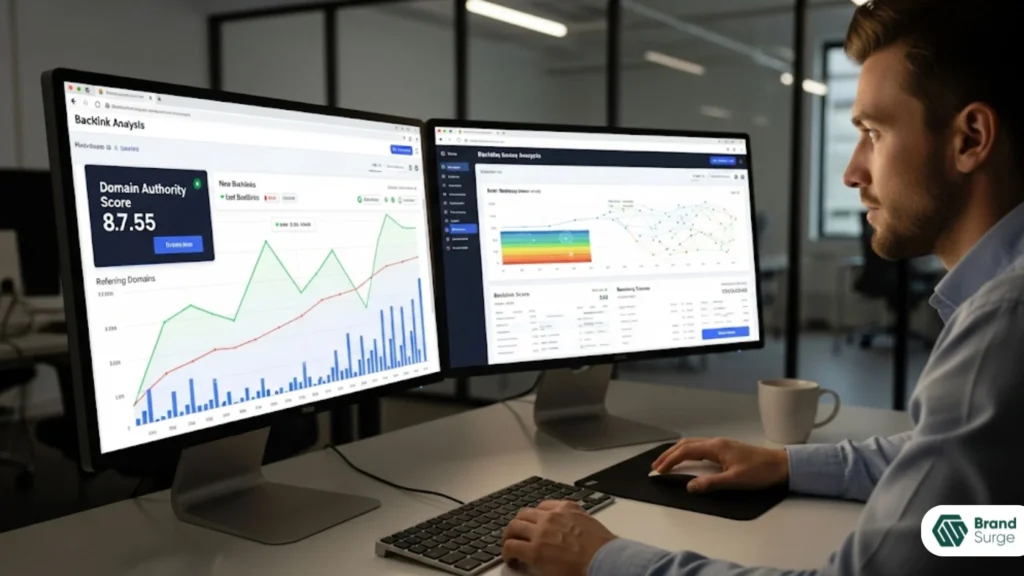
Link profiles remain a cornerstone SEO signal, and the quality of backlink data sets the stage for effective outreach. Semrush’s Backlink Analytics module provides real-time monitoring of referring domains, anchor text distribution, and follow versus no-follow ratios. Users can track new and lost links daily, empowering agile link building campaigns. Moz Pro’s Link Explorer focuses on trust metrics like Domain Authority and Spam Score, giving teams a quick lens into link quality before pursuing outreach.
Semrush surpasses many competitors with its sheer backlink index scale, claiming updates as frequently as every 15 minutes. This velocity ensures emerging links—both positive and negative—get flagged promptly. Moz Pro typically syncs link data on a weekly basis but excels in identifying toxicity by scoring domains against proprietary spam algorithms. High-risk link profiles can be isolated swiftly, making Moz Pro adept at audits before disavow submissions to Google Search Console.
Both tools offer robust link intersect and competitor backlink gap analyses. Semrush lets users identify domains linking to competitors but not to their own site, enabling targeted outreach. Moz Pro’s Comparative Link Metrics streamline side-by-side domain audits, presenting actionable insights on where to prioritize link building efforts. Marketing teams should consider whether advanced filtering (Semrush) or simplified comparative reports (Moz Pro) best suits their outreach workflows.
Broken link building and outreach integrations further differentiate the offerings. Semrush automates the process: find broken pages on external sites, locate contact information, and launch email campaigns directly from the dashboard. Moz Pro relies on exported CSVs for outreach but integrates with popular email clients through community-driven extensions. Teams that prize turnkey outreach automation often choose Semrush, while those preferring bespoke email sequences may find Moz Pro’s flexible exports sufficient.
How effective are Semrush and Moz for site audits?
Comprehensive site audits uncover technical SEO issues and optimize crawling efficiency, making this functionality vital for any professional toolkit. Semrush’s Site Audit tool scans domains for over 140 issues, ranging from broken pages and duplicate content to HTTPS misconfigurations and schema implementation. It visualizes audit progress over time, enabling teams to track remediation and demonstrate improvements to stakeholders. Moz Pro’s Site Crawl feature tackles 100+ checks, emphasizing core elements like meta descriptions, canonical tags, and page speed metrics.
Scalability is a standout factor in Semrush’s audit engine, allowing users to crawl up to 20,000 pages in the Pro plan—scalable to 100,000 pages on higher tiers. This flexibility supports large-scale websites with deep architectures. Moz Pro caps crawls at 300,000 URLs per campaign but segments issues into custom priority levels, helping teams triage high-impact fixes first. Businesses with extensive content inventories should weigh crawl capacity against issue prioritization features.
Visual reporting within each platform caters to different needs. Semrush offers customizable PDF reports with brand logos, white label options, and modular report sections for executive summaries. Moz Pro generates straightforward CSV exports and on-screen dashboards that highlight critical issues through color-coded bars. Companies preparing regular client deliverables may benefit from Semrush’s polished reporting, while in-house teams might appreciate Moz Pro’s direct data feeds for internal analytics tools.
Both platforms integrate audit insights with on-page optimization recommendations. Semrush proactively suggests action cards—such as “add missing hreflang tags”—and links to knowledge base articles for guidance. Moz Pro provides inline tips within each issue report, pointing to best practice guidelines in the Moz Blog. Teams should evaluate whether hands-on guidance (Semrush) or self-guided learning (Moz Pro) aligns better with their proficiency levels.
How do Semrush vs Moz handle rank tracking and competitor analysis?
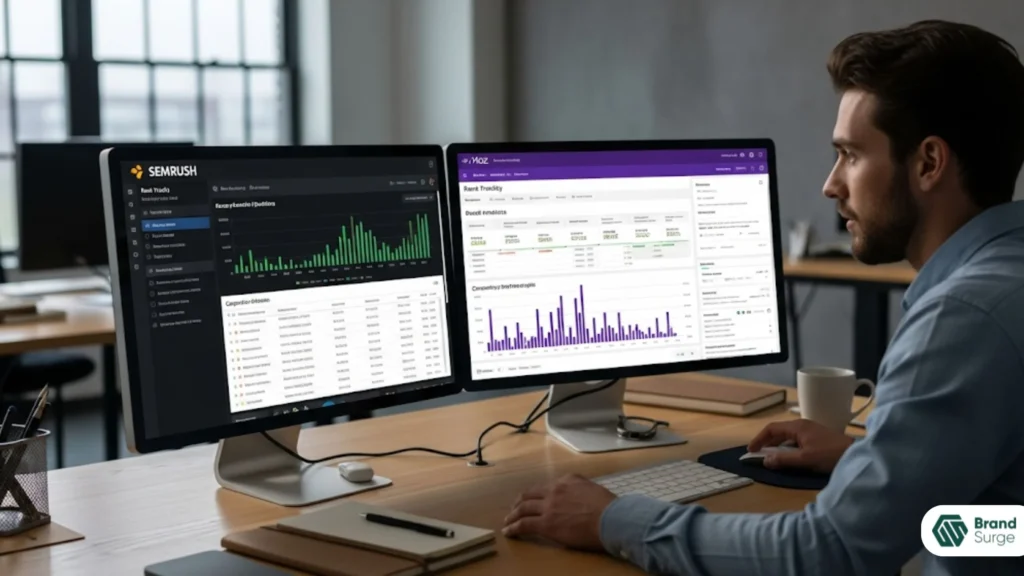
Accurate rank tracking and competitor benchmarking inform campaign adjustments and highlight emerging opportunities. Semrush offers daily rank updates for up to 500 keywords in the Pro plan, with higher tiers unlocking 1,500 or more tracked terms. Users can segment keywords by device, location, and search feature to refine insights. Moz Pro, by contrast, provides weekly updates for 300 keywords in its Standard tier, with up to 500 keywords on higher plans. Smaller teams or those with less frequent reporting needs may find Moz Pro’s cadence sufficient.
Competitor analysis in Semrush extends beyond keyword overlap into ad research, display advertising intelligence, and traffic analytics. Users gain visibility into competitors’ paid search budgets, top landing pages, and display creative. Moz Pro focuses primarily on organic benchmarks, comparing domain authority trends and top performing pages across a limited set of competitor domains. Businesses invested in hybrid SEO-PPC strategies often rely on Semrush’s holistic view, while exclusively organic players may appreciate Moz Pro’s streamlined organic focus.
Alerts and automated reporting further differentiate each platform’s approach. Semrush can trigger real-time notifications for significant ranking changes or new domain mentions, pushing updates via email or Slack integration. Moz Pro’s Campaigns feature delivers weekly email digests summarizing core metrics like keyword movements and backlink profiles. Teams seeking proactive signals will gravitate toward Semrush’s live alerting, whereas those on tight email schedules might prefer Moz Pro’s periodic campaign summaries.
Integrations with external analytics amplify competitor comparisons. Semrush feeds ranking data directly into Google Data Studio or Tableau through connectors, making deeper custom analysis possible. Moz Pro’s API allows for bespoke dashboard builds but requires more development resources to set up. Organizations with dedicated data engineers may extract maximum value from Moz Pro’s API, while those needing plug-and-play dashboards lean on Semrush.
What features support content marketing and reporting?
Content marketing modules have become essential for SEO suites aiming to serve broader digital strategies. Semrush’s Content Marketing Platform includes tools like Topic Research, SEO Writing Assistant, and Content Audit, which analyze performance metrics across blog posts and landing pages. It surfaces content gaps, suggests semantically related keywords, and grades drafts based on readability, originality, and SEO best practices. Moz Pro offers On-Page Grader and Content Suggestions, focusing on keyword targeting and on-page element compliance rather than holistic content lifecycle management.
In terms of editorial workflows, Semrush integrates with Google Docs and WordPress, letting writers optimize drafts in real time without leaving their writing environment. Moz Pro delivers standalone recommendations in the platform, which content teams then export and implement manually. Organizations with established CMS processes may leverage Semrush’s native plugins for seamless optimization, whereas those preferring centralized task management can adapt Moz Pro’s exported checklists.
Reporting flexibility is another key differentiator. Semrush’s My Reports feature allows users to build and schedule fully branded PDF reports, pulling in data from multiple Semrush tools along with third-party widgets. Moz Pro’s Campaign reporting consolidates key insights into a single dashboard view, accessible to team members via shared links. Clients or stakeholders expecting polished deliverables often favor Semrush’s white label capabilities, while internal teams might find Moz Pro’s centralized campaign dashboards more than adequate for progress tracking.
Keyword and content performance insights converge in both tools to provide ROI measures. Semrush calculates traffic potential for target keywords and models projected growth if you capture top positions. Moz Pro correlates keyword ranking positions with estimated monthly visits, offering a snapshot of current value. Teams looking for predictive modeling will benefit from Semrush’s forecasting features, while those satisfied with present-state metrics can rely on Moz Pro’s clear visit estimates.
What is the user experience like on Semrush vs Moz?
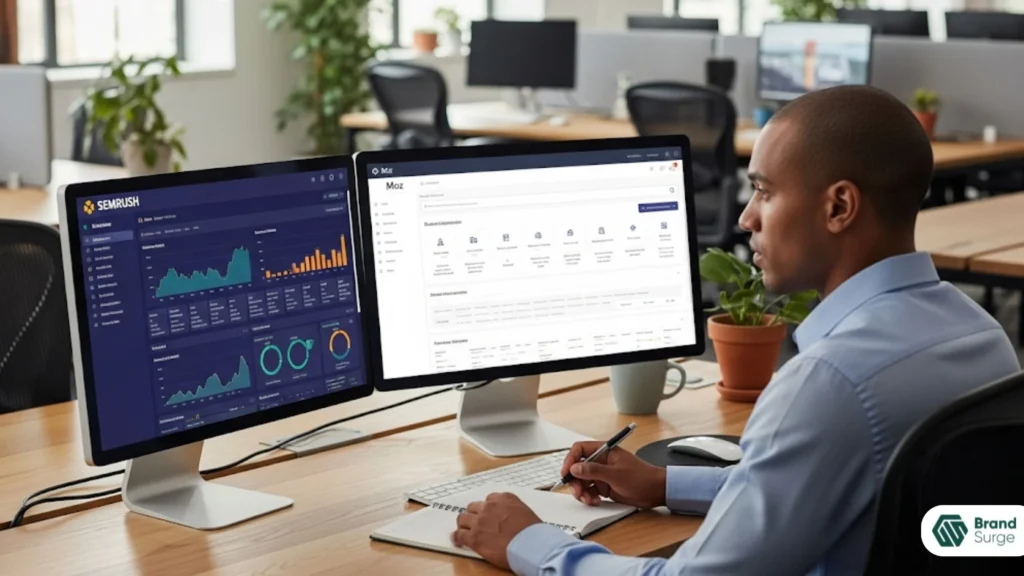
User interface design and workflow intuitiveness can significantly affect team adoption and productivity. Semrush’s dashboard is modular, with a left-hand navigation panel guiding users through project setup, keyword research, site audit, and competitor analysis in a logical sequence. Each module offers interactive graphs and drill-down filters that empower users to customize views without coding. Conversely, Moz Pro presents a streamlined layout, with high-contrast charts and a straightforward top-menu navigation that emphasizes core features over extended functionality.
Learning curves differ between the platforms. Semrush’s breadth of tools requires an initial orientation period to fully leverage each module’s capabilities. However, drag-and-drop report builders and contextual help tooltips mitigate complexity for new users. Moz Pro’s narrower focus often results in quicker time-to-value, especially for teams whose primary goal is to track rankings and monitor link health. Organizations evaluating onboarding time against feature requirements should weigh Semrush’s richness against Moz Pro’s simplicity.
Mobile and tablet accessibility also vary. Semrush provides a dedicated mobile app for rank tracking and domain overview metrics, helping users check performance on the go. Moz Pro relies on responsive web design for mobile access, which offers core dashboards but lacks certain interactive features. SEO professionals who need quick rank checks between meetings tend to prefer Semrush’s app, while casual users comfortable with occasional mobile log-ins find Moz Pro adequate via browser.
Community resources complement each platform’s user interface. Semrush hosts an extensive resource library, including webinars, certification courses, and an active LinkedIn group where practitioners share hacks and updates. Moz Pro maintains the Moz Blog, Whiteboard Friday videos, and a highly engaged Q&A forum, fostering deep SEO discussions. Teams looking for structured training might lean toward Semrush Academy, while those who value peer-to-peer troubleshooting often gravitate to Moz’s community forums.
Semrush vs Moz: Which offers better ROI?
Semrush vs Moz both present tiered pricing models that aim to deliver value across teams of varying sizes.
Semrush vs Moz pricing tiers start with Semrush Pro at $129.95 per month (billed monthly) and Moz Pro Standard at $99 per month. Semrush’s higher entry point reflects the inclusion of advanced analytics and content marketing features that Moz Pro restricts to premium plans. Users must calculate whether expanded toolsets—like PPC research, brand monitoring, and social media tracking—justify the incremental cost.
Semrush vs Moz’s mid-tier plans diverge in capacity and access. Semrush Guru at $249.95 per month unlocks historical data, multi-user access, and extended limits on projects and keywords. Moz Pro Medium at $179 per month increases rank tracking and allows API access but still lacks certain marketing add-ons. Teams scaling rapidly will need to forecast tool lock-in costs as their project volume grows.
Semrush vs Moz also differs in trial and contract flexibility. Semrush custom plans can be negotiated for annual commitments, often with negotiated discounts and personalized onboarding. Moz Pro offers a 30-day money-back guarantee, affording teams a risk-free trial period before full commitment. Organizations sensitive to upfront costs can leverage Moz Pro’s guarantee, while those ready to lock in long-term savings might negotiate Semrush’s annual package.
Overall return on investment hinges on how deeply each team taps into the available modules. Companies that require an all-in-one SEO and marketing platform will realize greater ROI from Semrush’s extensive feature suite. Teams focused primarily on organic search and domain authority metrics may extract sufficient value from Moz Pro’s targeted toolset at a lower price point.
Which tool suits small businesses, agencies, and enterprises?

Small businesses often operate with limited budgets and need straightforward value propositions from software investments. Moz Pro’s Standard tier at $99 per month often meets the needs of smaller teams by delivering essential rank tracking, backlink analysis, and on-page optimization insights. Its curated workflows and weekly email digests simplify SEO management without overwhelming users. By contrast, Semrush’s higher entry pricing may require a more deliberate budget allocation for small-scale operations.
Digital agencies that service multiple clients demand scalable toolsets, white label reporting, and collaboration features. Semrush’s agency plans include extended limits on projects and users, plus brandable PDF reports and agency-friendly billing options. Moz Pro’s Agencies plan offers increased keyword tracking and API access, but agencies typically find themselves upgrading faster to unlock advanced data pipelines. Teams that value polished client deliverables and robust collaboration features often standardize around Semrush.
Enterprises with global footprints and large content inventories require enterprise-level data volumes and security controls. Semrush Business and Enterprise plans boast SSO integration, dedicated account managers, and custom feature development to align with internal workflows. Moz Pro’s Custom plan offers similar enterprise support but may require additional investments to meet large-scale crawling and API throughput demands. Organizations operating at scale must compare SLA commitments and data governance across both platforms.
Geographic distribution plays a role in deployment decisions. Firms targeting multiple international markets will appreciate Semrush’s 200+ country databases and localized reporting. Moz Pro supports key markets but lags in certain regional datasets, potentially requiring supplementary tools. Enterprises planning global expansion must ensure their chosen platform can deliver consistent insights across all target geographies.
Semrush vs Moz: real user feedback and reviews
Peer reviews often surface recurring themes around usability, data quality, and customer support. Many users praise Semrush for its comprehensive toolset, noting that it serves as an all-in-one SEO hub for keyword research, content planning, and competitor spying. Positive feedback frequently highlights Semrush’s frequent feature updates and AI-powered insights that accelerate decision-making. Conversely, some users cite the platform’s complexity and steep learning curve as drawbacks for new team members.
Moz Pro reviewers regularly commend the platform’s intuitive interface and clear metric definitions, particularly Domain Authority and Spam Score, which resonate with both beginners and seasoned SEOs. The tight focus on core SEO functions and transparent documentation earns Moz Pro high marks for simplicity and community engagement. Criticisms often focus on slower data refresh cycles and fewer advanced modules compared to Semrush, leading some teams to supplement Moz Pro with additional tools.
Customer satisfaction surveys further underscore support differences. Semrush’s 24/7 live chat and dedicated account managers receive high ratings for responsiveness and technical expertise. Moz Pro users appreciate the community-driven support model, which allows them to crowdsource solutions in public forums and webinars led by SEO veterans. Organizations must decide whether they value direct vendor support (Semrush) or peer-driven collaboration (Moz Pro).
Budget-conscious teams often compare the cost-to-feature balance. Many users agree that Semrush’s higher price point is justified by the platform’s breadth, particularly when managing multi-channel marketing campaigns. Moz Pro’s more accessible entry price consistently attracts startups and small enterprises prioritizing core SEO tasks. Real-world feedback suggests that the ideal choice depends on an organization’s tolerance for complexity versus budget constraints.
How to integrate Semrush or Moz into your SEO audit workflow?
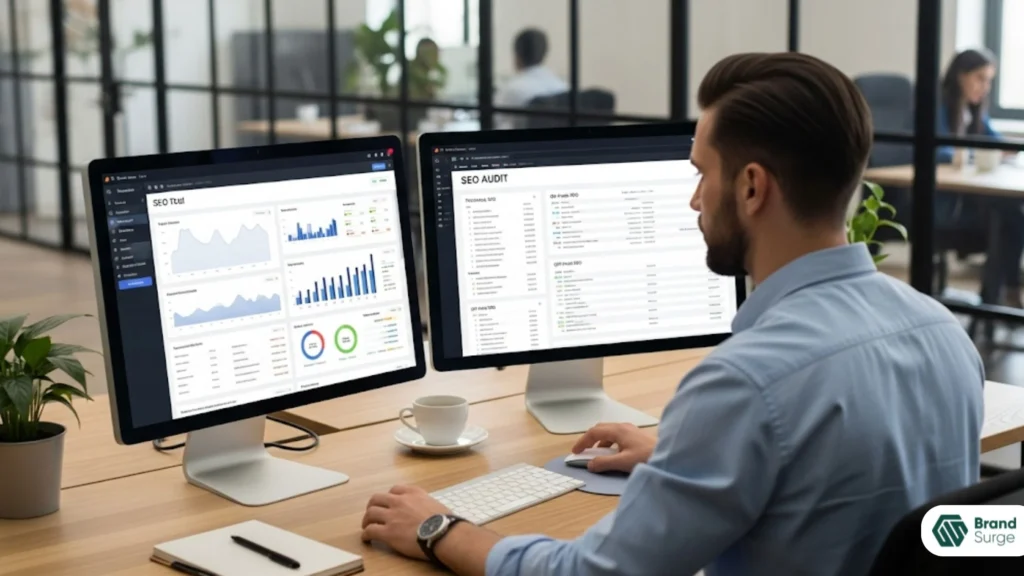
Implementing a structured SEO audit process ensures consistent insights and actionable recommendations. Semrush’s Audit Dashboard can be configured to run automatically on a set schedule, delivering fresh technical reports and prioritized issue lists straight to your inbox. Teams can then assign remediation tasks directly within the platform, tracking progress and verifying fixes in subsequent audits. Moz Pro’s Campaigns module similarly schedules site crawls and aggregates issues into a single report, which can be exported for integration into project management tools.
Linking audit data with on-page optimization workflows is critical for maintaining site health. Semrush allows you to send on-page suggestions to content authors via Google Docs integration, ensuring every page update aligns with SEO best practices. Moz Pro’s Page Optimization feature provides targeted guidance on key elements like title tags, meta descriptions, and heading structure, which teams can copy into their CMS or Google Sheets. By embedding these suggestions into writer or developer processes, you eliminate manual handoffs and speed up fixes.
Tracking progress over time requires reliable benchmarks. Semrush’s Audit Comparison widget graphs historical performance, making it easy to showcase improvements after each remediation cycle. Moz Pro’s Campaign snapshots do the same within the dashboard, highlighting resolved issues and new concerns. Teams can export these charts into monthly or quarterly reports for stakeholders, demonstrating the impact of SEO investments on site health.
To deepen the impact of your technical audit and maximize organic performance, explore our SEO Services.
Semrush vs Moz: Which is more future-proof?
Adapting to evolving search engine algorithms and digital marketing trends demands flexible tools and proactive innovation. Semrush invests heavily in artificial intelligence, introducing features like AI-driven topic clustering and automated content briefs. These developments help teams anticipate changes in user behavior and search intent. Moz Pro enhances its platform incrementally, refining its spam detection algorithms and expanding data sources, but typically focuses on steady improvements rather than groundbreaking feature rollouts.
Semrush’s commitment to integrating new marketing channels—such as social media tracking and voice search analytics—positions it as a multi-channel command center for digital teams. Moz Pro remains squarely within the SEO realm, optimizing its core toolset for on-page and off-site SEO metrics. Businesses aiming for an all-in-one marketing platform will find Semrush better equipped to scale across channels, whereas those seeking a best-in-class SEO specialist tool may value Moz Pro’s singular focus.
The pace of data updates also reflects future-proofing. Semrush’s near-real-time data refresh cycles ensure that the latest algorithm shifts and market moves are captured promptly. Moz Pro’s weekly data updates can introduce a short lag in identifying sudden ranking fluctuations. Organizations that require rapid response to search landscape changes—such as news publishers or time-sensitive campaigns—will benefit from Semrush’s faster cadence.
Finally, community engagement and thought leadership signal long-term viability. Semrush Academy and its certification programs foster a growing base of certified practitioners, promoting standardized methodologies. Moz Pro’s ongoing commitment to Whiteboard Friday and industry research reports like the Google Algorithm Update Tracker cements its status as a thought leader. Both platforms demonstrate a clear roadmap for ongoing innovation, ensuring long-term support for evolving SEO needs.
If you’re ready to elevate your search visibility or have questions about customizing your strategy, don’t hesitate to Contact us.
Before you decide on a platform, remember that successful SEO requires ongoing refinement, informed by accurate data and aligned with your organizational goals. Our experts at Brand Surge LLC stand ready to guide your team through every step of the SEO journey, leveraging the full power of Semrush or Moz Pro as your needs dictate.
Conclusion: Semrush vs Moz, which is a better all-in-one SEO tool?
Choosing between Semrush vs Moz ultimately hinges on your team’s priorities, budget, and marketing scope. Semrush shines as a comprehensive digital marketing suite, offering extensive keyword research, deep backlink analysis, advanced rank tracking, and multi-channel integrations that scale from small businesses to global enterprises. Moz Pro delivers a focused SEO software experience with industry-standard metrics, intuitive workflows, and a strong community backbone at a more accessible entry price.
For teams seeking an all-in-one SEO tool that encompasses content marketing, PPC research, social media insights, and automated reporting, Semrush provides the breadth and data volume to support ambitious growth initiatives. Organizations that require a specialized, streamlined SEO platform with clear guidance on link building and technical audits may find Moz Pro better aligned with their core objectives.
Ultimately, the best choice depends on your willingness to trade feature depth for simplified workflows or vice versa. By carefully mapping your current needs and future expansion plans, you can harness either Semrush or Moz to deliver consistent, measurable improvements in organic performance. Partner with Brand Surge LLC to implement your chosen platform, maximize your ROI, and stay ahead in the ever-changing world of search.
Frequently Asked Questions
What are the main differences between Semrush and Moz Pro?
Semrush offers a broader suite of digital marketing modules beyond core SEO, including PPC research, social media management, and content marketing tools. Moz Pro focuses on essential SEO functions like keyword research, site audits, and backlink analysis with clear metrics like Domain Authority and Spam Score.
Is Semrush or Moz better for keyword research?
Semrush excels in breadth, tapping into over 25 billion keywords with advanced filtering by intent, questions, and related topics. Moz Pro emphasizes depth, providing click-through rate estimates and priority scoring to help teams focus on high-impact keywords.
Which platform is more affordable, Semrush or Moz Pro?
Moz Pro Standard starts at $99 per month, making it more accessible for small teams. Semrush Pro begins at $129.95 per month but includes additional marketing features that justify the higher cost for growing businesses or agencies.
Can Moz Pro compete with Semrush’s backlink analysis?
Moz Pro’s Link Explorer offers robust domain authority metrics and spam scoring, ideal for quality assessments. Semrush’s larger backlink index and real-time updates provide more comprehensive coverage and automation for large-scale link monitoring.
How do Semrush vs Moz handle technical SEO audits?
Semrush scans up to 140 issues across technical, on-page, and crawlability checks with automated remediation suggestions. Moz Pro evaluates over 100 site health factors, prioritizes critical fixes, and offers inline guidance linked to best practice resources.

